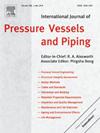Design method of a novel composite lining under high internal water pressure: An application in the water conveyance tunnel through urban areas
IF 3
2区 工程技术
Q2 ENGINEERING, MECHANICAL
International Journal of Pressure Vessels and Piping
Pub Date : 2025-02-28
DOI:10.1016/j.ijpvp.2025.105492
引用次数: 0
Abstract
A novel composite lining has been proposed by setting steel tube, self-compacted concrete (SCC) and composite plastic drainage board (CPDB) inside the segmental lining in a water conveyance tunnel through urban areas. The CPDB between the SCC and the segmental lining affects the performance of the lining. The potential sliding between the steel tube and SCC, as well as between the SCC and segmental lining, has a substantial impact on the structural bearing capacity. Therefore, the finite element model of the composite lining was built based on the concrete damage plasticity model and the Coulomb friction model. The bearing ratio of each layer before and after fracture failure of the SCC were analyzed. It was found that the internal water pressure is mainly shared by surrounding rock. The bearing ratio of the steel tube is significantly lower than expected. Consequently, the design method of the composite lining was proposed based on the d/E of the CPDB (the ratio of the thickness d to its comprehensive elastic modulus E). The design philosophy of the novel composite lining is that the steel tube shares most of the internal water pressure. It can be achieved by controlling the d/E within the range of 12.4–45.1 mm3/N. Also, the crack resistance of the segmental lining and the allowable steel tube stress are satisfied.
高内水压下新型复合衬砌的设计方法:在穿越城市地区的输水隧道中的应用
在某城市输水隧道管片衬砌中,采用钢管、自密实混凝土(SCC)和复合塑料排水板(CPDB)复合衬砌。SCC与管片衬砌之间的CPDB影响衬砌的性能。钢管与混凝土衬砌之间、混凝土衬砌与管片衬砌之间的潜在滑动对结构承载能力有重大影响。因此,基于混凝土损伤塑性模型和库仑摩擦模型,建立了复合衬砌的有限元模型。分析了SCC断裂破坏前后各层的承载比。研究发现,内部水压主要由围岩分担。钢管承载比明显低于预期。因此,提出了基于CPDB的d/E(厚度d与其综合弹性模量E之比)的复合衬砌设计方法。新型复合衬砌的设计理念是钢管分担大部分内水压。将d/E控制在12.4-45.1 mm3/N范围内即可实现。管片衬砌的抗裂性能和钢管许用应力均满足要求。
本文章由计算机程序翻译,如有差异,请以英文原文为准。
求助全文
约1分钟内获得全文
求助全文
来源期刊
CiteScore
5.30
自引率
13.30%
发文量
208
审稿时长
17 months
期刊介绍:
Pressure vessel engineering technology is of importance in many branches of industry. This journal publishes the latest research results and related information on all its associated aspects, with particular emphasis on the structural integrity assessment, maintenance and life extension of pressurised process engineering plants.
The anticipated coverage of the International Journal of Pressure Vessels and Piping ranges from simple mass-produced pressure vessels to large custom-built vessels and tanks. Pressure vessels technology is a developing field, and contributions on the following topics will therefore be welcome:
• Pressure vessel engineering
• Structural integrity assessment
• Design methods
• Codes and standards
• Fabrication and welding
• Materials properties requirements
• Inspection and quality management
• Maintenance and life extension
• Ageing and environmental effects
• Life management
Of particular importance are papers covering aspects of significant practical application which could lead to major improvements in economy, reliability and useful life. While most accepted papers represent the results of original applied research, critical reviews of topical interest by world-leading experts will also appear from time to time.
International Journal of Pressure Vessels and Piping is indispensable reading for engineering professionals involved in the energy, petrochemicals, process plant, transport, aerospace and related industries; for manufacturers of pressure vessels and ancillary equipment; and for academics pursuing research in these areas.

 求助内容:
求助内容: 应助结果提醒方式:
应助结果提醒方式:


